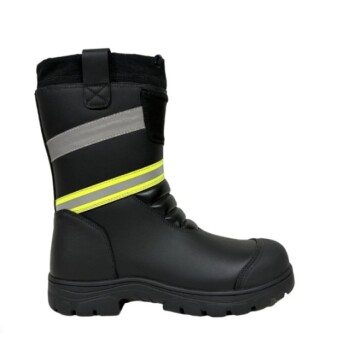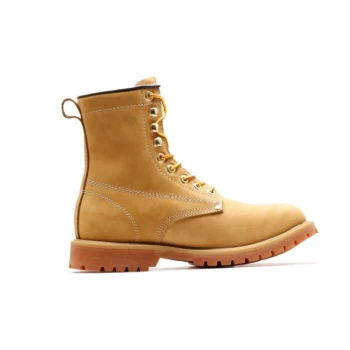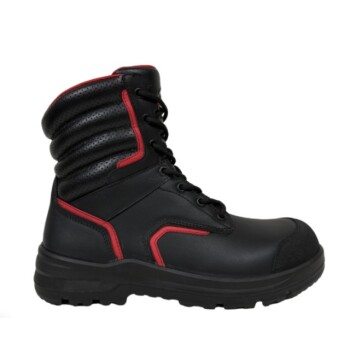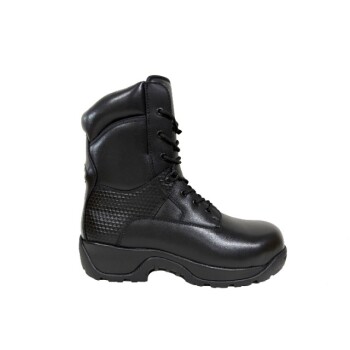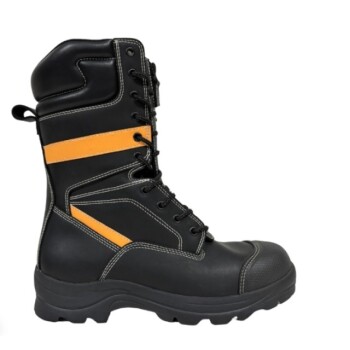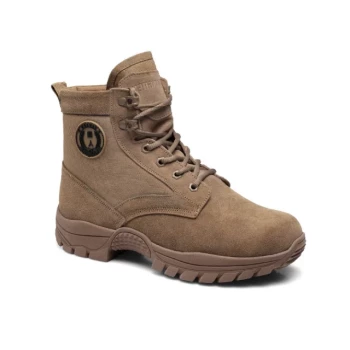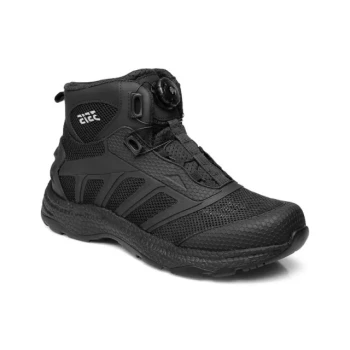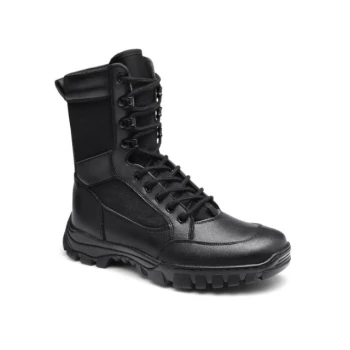At its core, the footwear a firefighter wears is a critical piece of personal protective equipment, falling into two main categories: traditional rubber bunker boots and modern leather boots, each designed for the extreme demands of firefighting. Both styles must meet stringent standards for protection against heat, punctures, and impacts.
Firefighter boots are not a one-size-fits-all solution. The choice between different styles and materials represents a critical trade-off between ease of decontamination, long-term comfort, and ankle support for specific firefighting environments.

The Two Styles of Structural Firefighting Boots
Firefighters on the front lines of an urban or structural fire rely on heavy-duty boots, often called bunker or turn-out boots. The choice of material and design within this category directly impacts their safety and performance.
Traditional Rubber Boots
The classic firefighter boot is made of rubber. This material's primary advantage is its resistance to chemical and biological contaminants.
Rubber boots are significantly easier to decontaminate from substances like fuel or blood, which can penetrate and degrade other materials.
Modern Leather Boots
A growing number of firefighters now opt for leather boots. These are engineered to be lighter and to conform better to the shape of the foot.
This improved anatomical fit provides enhanced comfort and support, which is a major benefit during long incidents where firefighters are on their feet for extended periods. Their flexibility also makes it easier to operate vehicle pedals.
Lace-Up Combat-Style Boots
Within the leather category, many firefighters use combat-style lace-up boots. This design provides a much snugger fit around the ankle.
This superior ankle support is crucial for maintaining stability and preventing sprains when working on unstable ground, ladders, or roofs.
Core Protections: More Than Just Footwear
Firefighter boots are a multi-layered defense system designed to counter a wide range of on-the-job hazards. Their function goes far beyond simply covering the feet.
Defense Against Physical Hazards
Every certified fire boot includes reinforced safety toes to protect against crushing injuries from falling debris.
They also feature puncture-resistant soles to guard against sharp objects like nails and broken glass, which are common hazards in a fire scene.
Protection from Extreme Environments
Boots are built to withstand extreme heat and direct flame contact. They must also be waterproof to keep feet dry when wading through standing water.
This combination of features protects against burns, steam, and hazardous materials while providing insulation and comfort during long duty hours.
Support, Traction, and Agility
High ankle support is a key feature that helps prevent sprains and fractures on difficult terrain.
A proper fit, good traction on slippery surfaces, and the ability to move with agility are just as important as protection from external threats.
The Critical Trade-offs and Maintenance
Choosing and maintaining boots is a serious responsibility. Neglect or choosing the wrong boot for the environment can compromise safety.
The Decontamination Dilemma
The most significant trade-off is between comfort and safety from contamination. While leather is more comfortable, it is also more porous.
Scuffed or worn leather can absorb hazardous fluids like fuel or blood. Rubber remains the easiest and most reliable material to decontaminate, making it a preferred choice for hazmat situations.
Why Proper Care Is Non-Negotiable
Regular maintenance is essential to a boot's performance and lifespan. Firefighters must consistently clean, dry, and condition their footwear.
Proper care ensures the materials remain durable and continue to provide the necessary support and protection.
Conditioning Leather for Longevity
For leather boots, this means using specialized products like heavy-duty leather preservatives and oils.
These treatments keep the leather supple and prevent it from drying out and cracking, which would compromise its protective barrier.
Making the Right Choice for the Mission
The best boot is the one that matches the specific demands of the firefighter's primary role and environment.
- If your primary focus is hazardous materials response: The superior decontamination properties of traditional rubber boots make them the safest choice.
- If your primary focus is comfort and support during long structural fires: Modern leather boots offer a clear advantage in reducing fatigue and improving fit.
- If your primary focus is stability on ladders and uneven terrain: A snug, lace-up combat-style boot provides unparalleled ankle support to prevent injury.
Ultimately, a firefighter's boots are a foundational tool that directly impacts their safety, endurance, and effectiveness on the fireground.
Summary Table:
| Boot Type | Primary Material | Key Advantage | Best For |
|---|---|---|---|
| Traditional Boots | Rubber | Superior Decontamination | Hazmat Response |
| Modern Boots | Leather | Enhanced Comfort & Fit | Long Structural Fires |
| Combat-Style Boots | Leather | Unparalleled Ankle Support | Ladders & Uneven Terrain |
Ready to Equip Your Team with Professional-Grade Firefighting Boots?
As a large-scale manufacturer, 3515 produces a comprehensive range of certified safety footwear for distributors, brand owners, and bulk clients. We ensure every pair meets the highest standards for heat resistance, puncture protection, and durability.
Let us help you source the right boots for your specific operational needs. Contact our experts today for a consultation and quotation.
Visual Guide

Related Products
- High Performance Fire-Retardant Waterproof Safety Boots
- Safety Footwear Wholesale Manufacturer for Custom OEM/ODM Production
- Durable Goodyear Welt Leather Work Boots for Wholesale & Private Label
- Premium Wholesale Waterproof Safety Boots High Performance Protection for Industrial Markets
- Premium Grain Leather Safety Boots for Bulk Supply
People Also Ask
- How should one choose between steel toe and composite toe shoes? Match Your Work Hazards for Optimal Safety
- When are steel-toe boots required or recommended? Essential Guide to Workplace Foot Safety
- What standards are used to test and rate safety-toe footwear? Ensure Your Boots Are Truly Protective
- What factors should be considered when choosing between steel and composite toe caps? Ensure Maximum Safety and Comfort
- How can comfort be improved when wearing steel toe boots? A Guide to Pain-Free Workdays
